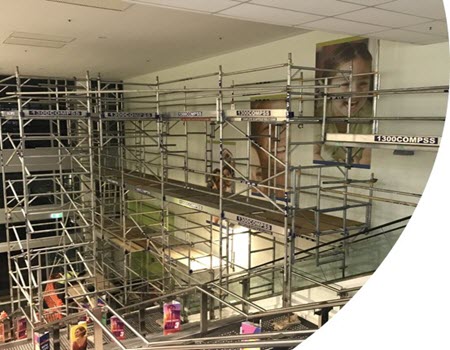Scaffolding is pretty resilient, but it’s not invincible. Damaged scaffolding can set back a project by days or weeks, so it’s important to be aware of the issues that can cause harm to it.
Extreme Weather Conditions
Anybody who’s lived in Australia will be aware of the severe weather variations that can occur. If you’ve got scaffolding that’s a bit worse for wear, the risks of weather-related damage becomes far higher. A severe example of these situations would be a hot humid summer day blazing down on exposed scaffold tubing. After this, a cold evening comes around and caused the metal in the scaffolding to constrict. On the next day after this, a huge thunderstorm might roll around and pour down on your scaffolding. The combination of heat followed by cold wind and rain creates a “perfect storm” for rust and corrosion. Once this has occurred, it won’t take long for your scaffolding to be severely compromised. Make sure that you’re cautious when it comes to the harsh Australian climate, because it can have a serious impact on the structural integrity of your scaffolding.
Excessive Weight
Another situation that can cause damage to your scaffolding is overloading. Scaffolding is designed to support the load of its own weight along workers and building materials all the way up to the highest platform. But if scaffolding is exposed to more weight than it is designed to bear, damage can occur quite suddenly and create a dangerous and costly situation. The fasteners can start to buckle, cross-beams can bend and bracing can begin to move. Make sure that your workers are aware of the limits of your scaffolding so they don’t overload it.
Incorrect Erection Procedures
It’s crucial that you adhere to Occupation Health and Safety standards when erecting and working with scaffolding. It’s crucial that the framework of your scaffolding is not exposed to asymmetric stress. A properly erected scaffolding system should connect with neighboring scaffold to cancel out the loading effect. Well fitted fasteners, structure-to-tower support lines and bracing mechanisms will help prevent scaffolding damage.
Wear and Tear
Scaffolding is essential on construction sites, as it gives workers the ability to work at-heights on multiple levels. However, scaffolding is subjected to many rough impacts over the course of a typical work day. Even while relocating the scaffolding from one site to another, the stacked pieces rub against each other. You can minimise the damage by correctly stacking your scaffolding before you transport it.
Incorrect Worker Training
Skimping on training for your workers can cause some serious issues down the track. Workers who allow dirt and mess to accumulate on your scaffolding or who leave tools and construction materials all over the place can cause damage without even knowing it. Make sure you train your workers properly so they don’t develop bad habits like these.
Out of all the issues we’ve listed above, it’s hard to find one culprit that stands out from the rest. All of these problems can combine and result in damage, so make sure you are aware of the risks so you can take precautionary measures like training your workers and reading up on WHS regulations.
Contact Complete Scaffold Solutions Today!
Whatever your access requirements are, you’ll want to work with a professional company with a track record of safety. Complete Scaffold Solutions are the chosen partner for more and more building companies in Brisbane, Sydney and indeed around the country for major projects. Give us a call today on 1300 266 777 or send an email to brad@compss.com.au to sort out all your scaffold needs.

